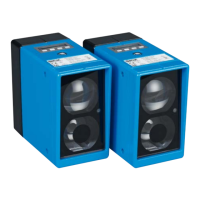What to do if the service life of the laser has been exceeded in SICK Transmitter?
- KKristen SampsonAug 13, 2025
If the service life of the laser in your SICK Transmitter has been exceeded, replace the device.

What to do if the service life of the laser has been exceeded in SICK Transmitter?
If the service life of the laser in your SICK Transmitter has been exceeded, replace the device.
What to do if the internal temperature of the SICK ISD400 Pro Transmitter is outside the permissible range?
If the internal temperature of your SICK Transmitter is outside the permissible range, take the following steps: * Check the ambient temperature and improve ventilation if needed. * Shield the device from radiant heat, such as direct sunlight. * If the ambient temperature is low, use a heating system for the device. * If the ambient temperature is high, consider using a cooling housing.
What to do if the current received signal level is below the recommended value in SICK ISD400 Pro?
If the current received signal level of your SICK Transmitter is below the recommended value: * Clean the outer optical surfaces. * Reduce the distance between the devices. * Realign the devices.
What to do if the current received signal level is below the warning threshold in SICK Transmitter?
If the current received signal level of your SICK Transmitter is below the warning threshold: * Clean the outer optical surfaces. * Reduce the distance between the devices. * Realign the devices.
What to do if the internal temperature of SICK Transmitter is approaching the limit of the permissible range?
If the internal temperature of the SICK Transmitter is approaching the limit of the permissible range: * Check the ambient temperature and improve ventilation. * Shield the device from radiant heat, for example, shade it from direct sunlight. * Use a heating system for the device at low ambient temperatures. * Use a cooling housing at high ambient temperatures.
What to do if the receiver unit is not aligned correctly in SICK ISD400 Pro Transmitter?
If the warning message that the receiver unit of your SICK Transmitter is not aligned correctly is displayed for more than 10 seconds, realign the devices until the warning message disappears permanently.
How to switch on the laser on SICK ISD400 Pro?
If the laser of your SICK Transmitter (Device F1 (ISD400-7xx1)) has been switched off for commissioning, switch it on by pressing the button.
What to do if the laser of SICK ISD400 Pro Transmitter is at the end of its service life?
If the laser of your SICK Transmitter is still ready for operation but is at the end of its service life, keep a replacement device ready for use.
| Protection class | IP67 |
|---|---|
| Synchronization | Yes |
| Operating voltage | 10 V DC ... 30 V DC |
| Connection | M12 connector |
| Light source | Laser |
Outlines the training and skill requirements for personnel operating the device.
Emphasizes observing safety notes and warnings to avoid dangerous situations.
Details the Class 1M laser warning labels and provides laser data.
Provides specific warnings and precautions related to laser beam and sender elements.
Explains minimum mounting distance requirements when operating multiple ISD400 Pro devices side-by-side.
Highlights safety precautions for incorrect supply voltage and working with live parts.
Steps for connecting the device electrically, ensuring no voltage is present.
Provides connection diagrams for supply voltage and Ethernet.
Step-by-step guide for aligning the sender and receiver devices for optimal performance.
Explains how to access and navigate the device's menu mode for configuration.
Details parameters within the menu mode for configuring multifunctional inputs and outputs.
Covers additional menu parameters like Ethernet link, signal level warnings, and heating control.
Instructions for resetting the device to its initial factory settings.
Lists common warning messages, their possible causes, and troubleshooting steps.
Lists common error messages, their possible causes, and troubleshooting steps.
Describes common error indicators and their troubleshooting solutions.